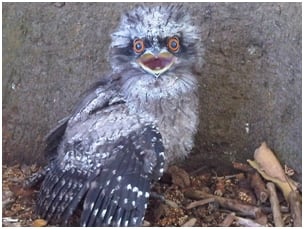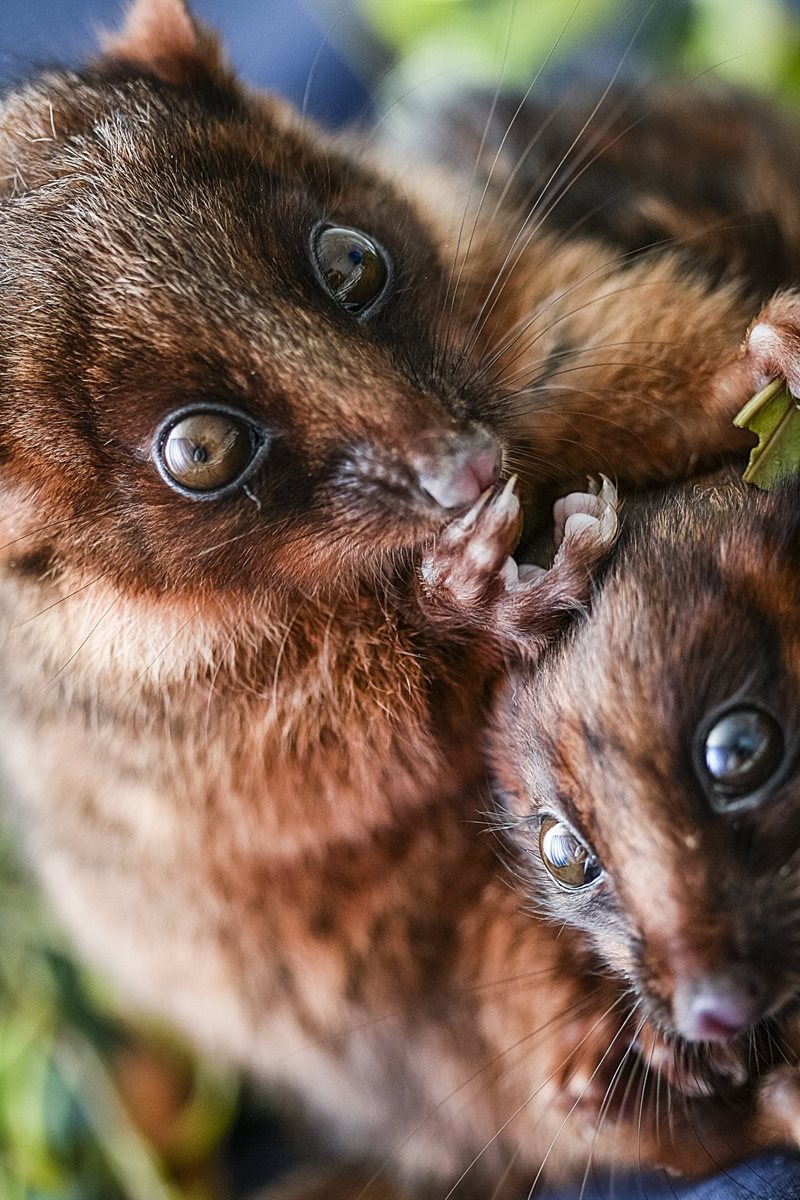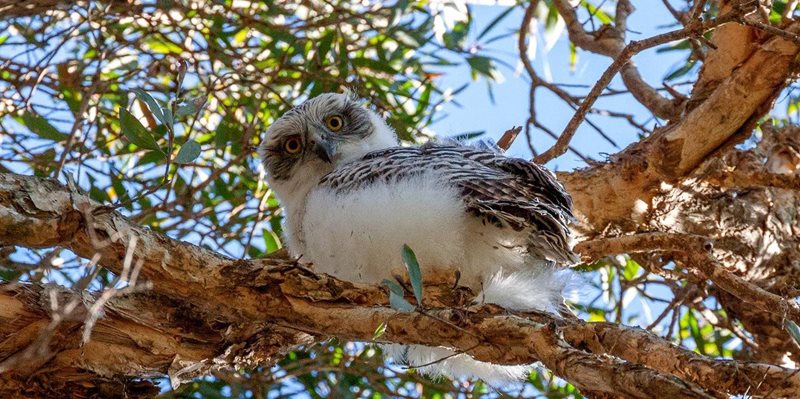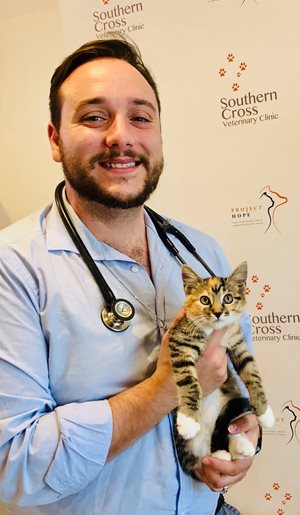Twilight (apart from being a blockbuster movie franchise) is the time of day between daylight and darkness colloquially known as dawn and dusk. These hours are critical for many of the native species which inhabit Centennial Parklands.
A large proportion of Australian native species are nocturnal, that is, they are active at night. The nocturnal lifestyle is a reality for a number of species inhabiting the Parklands, these include; possums (both common brushtail and ringtail possums), megabats (grey headed and black flying foxes), microbats (Gould’s wattled, Eastern bentwing and Eastern broad-nosed bats), owls (barn, Southern boobook and powerful owls) and other birds (tawny frogmouth).
 Fledging tawy frogmouth at the Park.
Fledging tawy frogmouth at the Park.
These species have evolved unique adaptations to facilitate their nocturnal lifestyles, some of which include:
-
Sight – acute low light eyesight in possums and owls.
-
Sound – acute hearing to detect danger and echolocation in bats to facilitate for night navigation.
-
Smell – possums and flying foxes have an acute sense of smell which allows them to locate food in low light by following scent trails.
Protecting our urban wildlife
We are all fortunate to have such a beautiful oasis in the centre of our city to enjoy. The Park is a wonderful recreational space shared by motorists, cyclists, walkers, riders, picnickers and sports people. We often forget that we also share it with who I like to consider our “landlords”, the species that call the Park home.
We are therefore responsible for their protection and conservation. We can help their cause by minimising our impact, especially at twilight when our nocturnal friends are most vulnerable.
It is during dawn and dusk that nocturnal wildlife are most commonly encountered by people in the Park. Some of the ways we can minimise our impact on these species in include:
-
Being vigilant and adhering to the speed limit (30 km/hr) at all times but particularly when driving at dawn or dusk through the Park. This reduces the risk of nocturnal wildlife coming into contact with cars, motorcycles or bicycles.
-
Keeping a safe distance and not disturbing any wildlife when coming across them. Do not use camera flashes or shine torches directly at the animals as this may startle them resulting in significant distress and disorientation.
-
Refraining from feeding the all wildlife as not only can this pose significant health risks but may result in animals becoming humanised (unnaturally comfortable around humans), thereby increasing the likelihood of being involved in dangerous situations involving cars, motorcycles or bicycles.
-
Keep dogs restrained in the designated on leash areas of the Park and ensure that they are effectively controlled around all wildlife, horses and ponds.
-
You don’t have to physically be in the Park to minimise your impact on the nocturnal species that live within it. If you reside in the neighbourhood, simply taking the precaution of keeping cats indoors at night significantly reduces predation rates of all wildlife in the Park.
As a veterinarian and wildlife carer with Sydney Wildlife, a large proportion of the native species I see in practice have been involved in cat-associated attacks. A simple cat bite or scratch is a serious medical issue for wildlife and without prompt veterinary attention is often fatal.
Furthermore, it is important to consider that coming across a nocturnal animal in daytime is not a normal occurrence and likely indicates that the animal is sick, injured or orphaned.
 A pair of Ringtailed possums at Centennial Parklands.
A pair of Ringtailed possums at Centennial Parklands.
Report injured wildlife
If you come across wildlife that appears sick, injured or orphaned please don’t hesitate to inform one of the Park’s rangers as well as promptly calling a wildlife rescue and care organisation like Sydney Wildlife on (02) 9413 4300 (24 hour service) or WIRES on 1300 094 737.
These amazing volunteer based organisations are dedicated to the rescue, rehabilitation and release of our native animals and are an amazing resource of information to members of the public interested in native wildlife.
 Powerful owlet at Centennial Park. Photo by Frank Martin
Powerful owlet at Centennial Park. Photo by Frank Martin
Care for our green spaces
Centennial Parklands is one of Australia's largest and most popular public spaces, hosting more than 31 million visits every year.
People aren't the only ones who visit so we encourage everyone to Share the Park with the animals and wildlife who rest, nest, eat and live in the Parklands.
Whether you visit as cyclist, pedestrian, dog walker, horse rider or a motorist, you can do some things to help us Share the Park:
About Dr Grima
BSC (HONS I) GRADCERTVETSTUD DVM
Dr. Michael joined the team at Southern Cross Veterinary Clinic in early 2019
after studying Veterinary Med icine at the University of Sydney before which he completed a Graduate Certificate in Veterinary Studies focusing on wildlife health and population management.
icine at the University of Sydney before which he completed a Graduate Certificate in Veterinary Studies focusing on wildlife health and population management.
He has a science background having majored in immunology and microbiology and has worked as
a medical scientist at a number of research institutions in Sydney including the Centenary Institute of Cancer Medicine and Cell Biology and the Heart Research Institute.
He has a particular interest in all things pathology, both clinical and anatomic, as well as internal medicine, dermatology, oncology, ophthalmology, exotic and wildlife medicine and aquatic medicine, and would be delighted to see your scaly, feathered and slimy friends.
In his free time, Dr. Michael loves to spend quality time with his beautiful wife Renee, family and friends. He enjoys relaxing by the coast and is an avid snorkeler who considers himself somewhat of an amateur marine biologist. He fills up his free time with bush walks, caring for sick, injured or orphaned wildlife, loves cooking up a storm, gardening, singing and caring for his tropical freshwater and marine fish and invertebrates, tree frogs and his cheeky feline son Chartreuse.